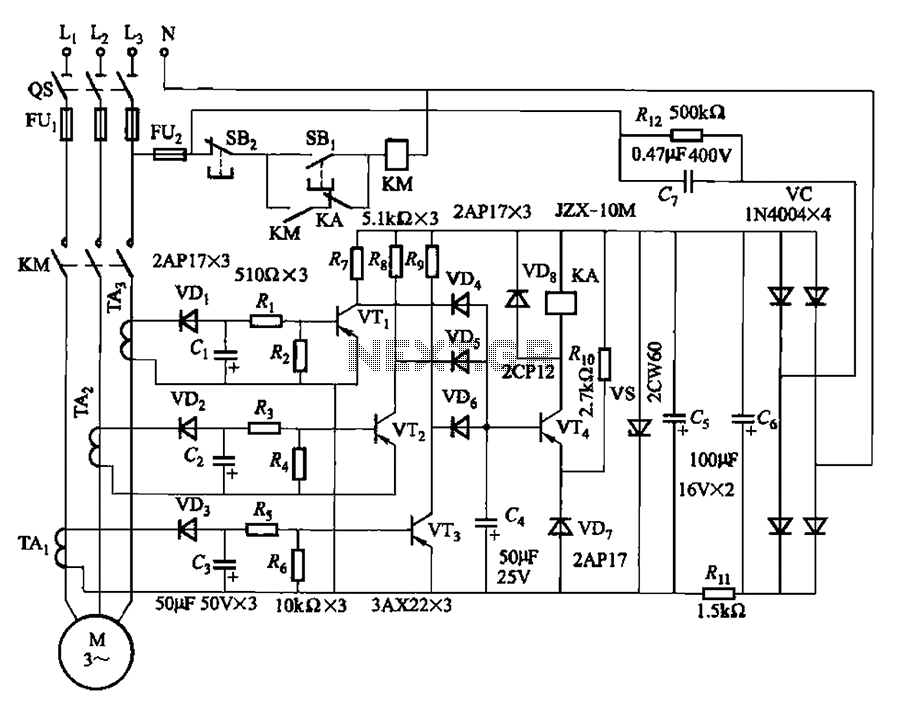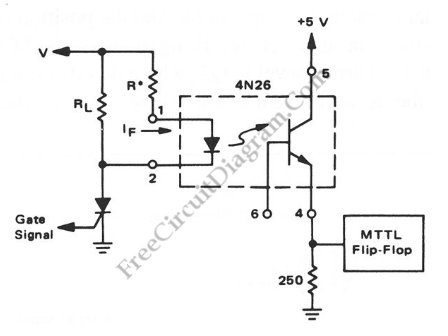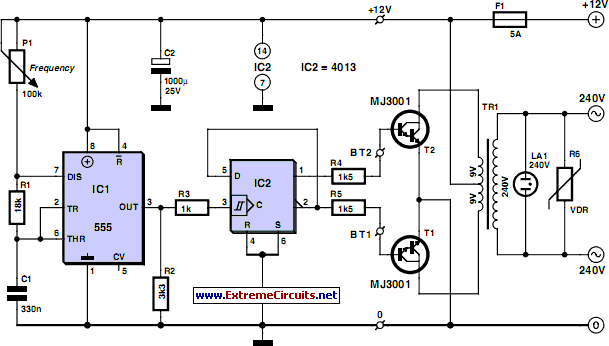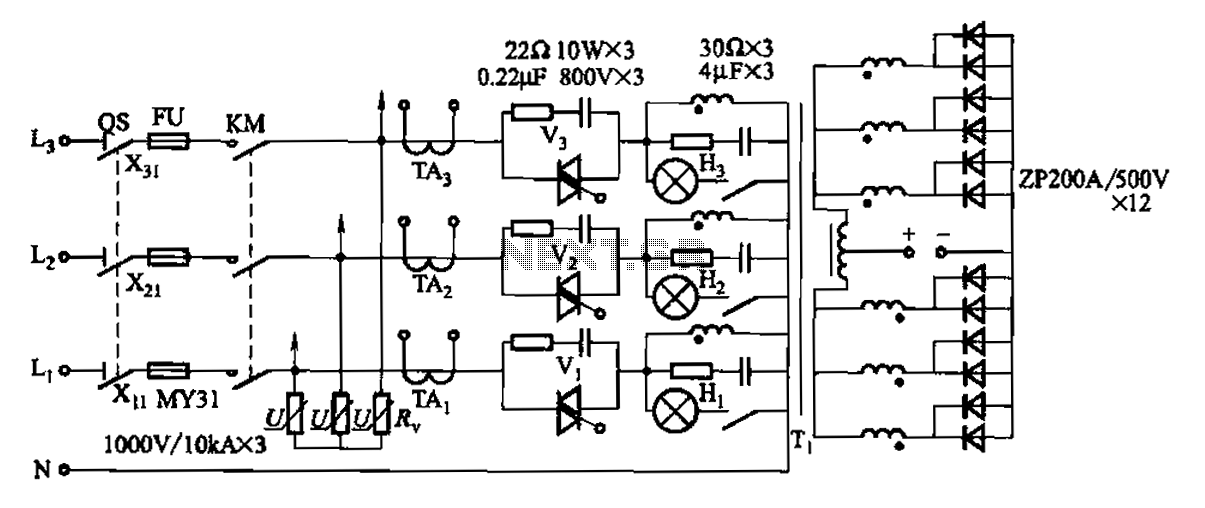
12V High current regulator
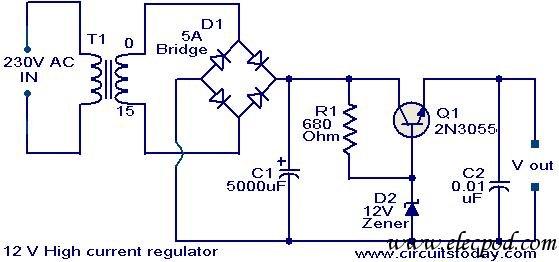
This voltage regulator circuit can deliver up to 3A at a 12V output voltage. The circuit is suitable for applications where a current exceeding 3A is required. Integrated circuit (IC) regulators with such high current ratings are difficult to source. The transformer T1 steps down the mains voltage to 12V RMS, and the rectifier bridge D1 converts it to a DC voltage. Capacitor C1 filters the rectifier output to produce a stable DC level. The series pass transistor Q1 (2N3055) is biased by resistor R1 (680 ohms). Since zener diode D2 operates in the breakdown region, the voltage across it will be 12V. Consequently, the total output voltage will theoretically be 11.3V, which is the zener voltage minus the base-emitter voltage of Q1. In this setup, transistor Q1 will conduct the additional current needed.
The voltage regulator circuit described is designed to provide a reliable output voltage of 12V with a current capacity of up to 3A. This is particularly useful in applications requiring stable power supply under variable load conditions. The circuit begins with transformer T1, which is responsible for stepping down the high-voltage AC mains supply to a lower voltage of 12V RMS. This is a critical first step in ensuring that the subsequent components operate within their safe voltage ratings.
The rectifier bridge D1, composed of four diodes arranged in a bridge configuration, converts the stepped-down AC voltage into pulsating DC. This pulsating DC is then smoothed out by capacitor C1, which acts as a filter to reduce voltage ripple, providing a more stable DC voltage output. The value of C1 is chosen based on the expected load current and the desired ripple voltage, ensuring that the output remains as steady as possible under varying load conditions.
The core of the voltage regulation is achieved through the use of the series pass transistor Q1, specifically the 2N3055 model. This transistor is capable of handling high currents, making it suitable for this application. The biasing of Q1 is accomplished through resistor R1, which sets the base current necessary for the transistor to operate in its active region. The zener diode D2 is crucial for maintaining the output voltage at a constant level. When operating in its breakdown region, D2 clamps the voltage across it to 12V, ensuring that the base voltage of Q1 remains stable.
The output voltage is theoretically calculated to be 11.3V, which accounts for the voltage drop across the base-emitter junction of Q1. This slight reduction from the zener voltage is important to note, as it impacts the overall performance of the voltage regulator. As the load current increases, Q1 will conduct the excess current, allowing the circuit to maintain the output voltage as specified. This design is particularly advantageous for applications that require a robust power supply capable of handling transient loads without significant voltage fluctuations.
Overall, this voltage regulator circuit is an effective solution for providing a stable 12V output at currents up to 3A, utilizing readily available components to achieve reliable performance in various electronic applications.This voltage regulator circuit can deliver up to 3A at 12V output voltage. The circuit can be employed on occasions when a current of more that 3A is demanded for regulator. IC regulators of such high current rating are pretty hard to find. The transformer T1 steps down mains voltage, to 12rms & the rectifier bridge D1 rectifies it to produce a DC voltage. The C1 filters the rectifier output and produces a DC level. The series pass transistor Q1 (2N 3055) is biased by resistor R1 (680 ). Since zener diode D1 is under breakdown region the voltage across it will be 12V. So the total output voltage will be steady 11. 3 V(theoretically). That is the zener voltage minus base emitter voltage of Q1. Here transistor Q1 will conduct the excess current required. 🔗 External reference
The voltage regulator circuit described is designed to provide a reliable output voltage of 12V with a current capacity of up to 3A. This is particularly useful in applications requiring stable power supply under variable load conditions. The circuit begins with transformer T1, which is responsible for stepping down the high-voltage AC mains supply to a lower voltage of 12V RMS. This is a critical first step in ensuring that the subsequent components operate within their safe voltage ratings.
The rectifier bridge D1, composed of four diodes arranged in a bridge configuration, converts the stepped-down AC voltage into pulsating DC. This pulsating DC is then smoothed out by capacitor C1, which acts as a filter to reduce voltage ripple, providing a more stable DC voltage output. The value of C1 is chosen based on the expected load current and the desired ripple voltage, ensuring that the output remains as steady as possible under varying load conditions.
The core of the voltage regulation is achieved through the use of the series pass transistor Q1, specifically the 2N3055 model. This transistor is capable of handling high currents, making it suitable for this application. The biasing of Q1 is accomplished through resistor R1, which sets the base current necessary for the transistor to operate in its active region. The zener diode D2 is crucial for maintaining the output voltage at a constant level. When operating in its breakdown region, D2 clamps the voltage across it to 12V, ensuring that the base voltage of Q1 remains stable.
The output voltage is theoretically calculated to be 11.3V, which accounts for the voltage drop across the base-emitter junction of Q1. This slight reduction from the zener voltage is important to note, as it impacts the overall performance of the voltage regulator. As the load current increases, Q1 will conduct the excess current, allowing the circuit to maintain the output voltage as specified. This design is particularly advantageous for applications that require a robust power supply capable of handling transient loads without significant voltage fluctuations.
Overall, this voltage regulator circuit is an effective solution for providing a stable 12V output at currents up to 3A, utilizing readily available components to achieve reliable performance in various electronic applications.This voltage regulator circuit can deliver up to 3A at 12V output voltage. The circuit can be employed on occasions when a current of more that 3A is demanded for regulator. IC regulators of such high current rating are pretty hard to find. The transformer T1 steps down mains voltage, to 12rms & the rectifier bridge D1 rectifies it to produce a DC voltage. The C1 filters the rectifier output and produces a DC level. The series pass transistor Q1 (2N 3055) is biased by resistor R1 (680 ). Since zener diode D1 is under breakdown region the voltage across it will be 12V. So the total output voltage will be steady 11. 3 V(theoretically). That is the zener voltage minus base emitter voltage of Q1. Here transistor Q1 will conduct the excess current required. 🔗 External reference
Warning: include(partials/cookie-banner.php): Failed to open stream: Permission denied in /var/www/html/nextgr/view-circuit.php on line 713
Warning: include(): Failed opening 'partials/cookie-banner.php' for inclusion (include_path='.:/usr/share/php') in /var/www/html/nextgr/view-circuit.php on line 713
